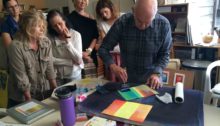Trihue Watercolor, Week 8
The eighth sessions of the Trihue Watercolor class for Winter 2018 were held on Wednesday, March 7 and Sunday, March 25. The surface and volume color homework was critiqued, and a review covered the whole course. All of the visual phenomena and principles covered in the course are tools you, as an artist, can choose to use, or not, depending on your goals. All have the potential to integrate and contribute to visual harmony, because they behave as nature does. Understanding them will allow you to create visual magic, whether working from nature or your own imagination.
Artist Kit Gentry joined the group by Skype for a question-and-answer session and discussion of artistic concerns.
A ninth, “Do-over” session was held on Wednesday, March 28, for people from both groups to bring reworked studies for critique. Much of the time was spent on the surface reflection exercise, and we have video of Dick illustrating and explaining how to plot reflections and shadows.







